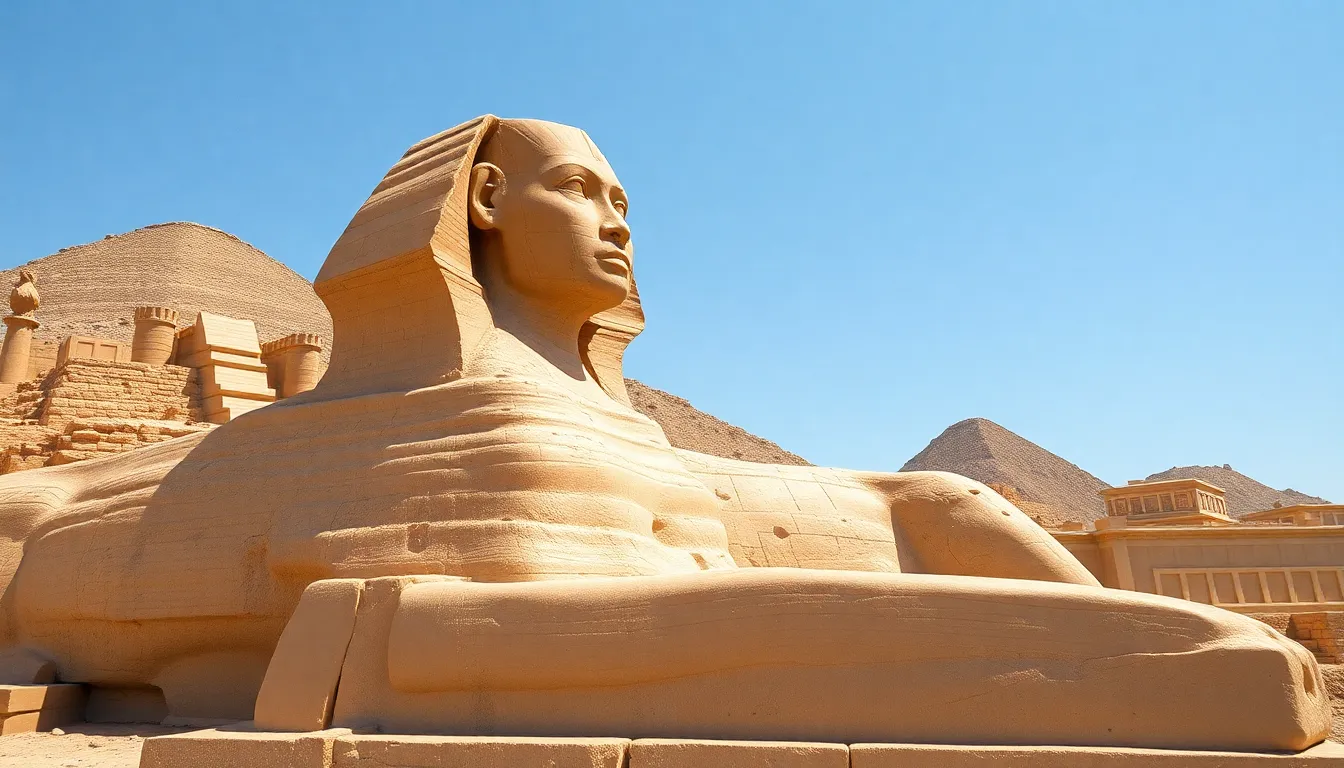Exploring the Sphinx’s Influence on Art and Sculpture
I. Introduction
The Sphinx, a mythical creature with the body of a lion and the head of a human, has captivated the imaginations of cultures for millennia. Originating in ancient Egypt, the Sphinx holds both historical and cultural significance, symbolizing strength and wisdom. This article aims to explore the Sphinx’s profound influence on art and sculpture throughout history, revealing how this enigmatic figure continues to inspire artists across time and cultures.
II. The Origins of the Sphinx
A. Historical context of the Sphinx in Ancient Egypt
The Great Sphinx of Giza, one of the most iconic monuments of ancient Egypt, dates back to around 2500 BCE during the reign of Pharaoh Khafre. Carved from limestone, this colossal statue measures approximately 73 meters long and 20 meters high. The Sphinx was believed to serve as a guardian to the Giza Plateau, protecting the tombs of the pharaohs.
B. Symbolism and meaning associated with the Sphinx
The Sphinx represents a fusion of human intellect and animal strength. In ancient Egyptian culture, it was often associated with the sun god Ra, symbolizing the passage between the earthly realm and the divine. The Sphinx also embodies the duality of nature: it is both a protector and a riddle, challenging those who encounter it.
III. The Sphinx in Ancient Art
A. Representations of the Sphinx in Egyptian sculpture
In ancient Egyptian art, the Sphinx was frequently depicted in various forms. Some of the notable representations include:
- Statues: Smaller sphinx statues often adorned temples and tombs.
- Reliefs: The Sphinx appeared in wall carvings, often accompanying depictions of pharaohs.
- Hieroglyphs: The Sphinx was also incorporated into hieroglyphic texts, emphasizing its importance in religious and cultural narratives.
B. The Sphinx in wall reliefs and frescoes
Wall reliefs and frescoes from ancient Egypt frequently showcased the Sphinx in various contexts. These artworks often depicted the Sphinx in association with other deities and royal figures, illustrating its role in the afterlife and the divine order. The Sphinx’s imposing presence served to reinforce the power of the pharaohs and the religious beliefs of the time.
IV. The Sphinx’s Impact on Classical Art
A. The Sphinx in Greek sculpture and mythology
The influence of the Sphinx extended beyond Egypt into Greek culture, where it became a symbol of mystery and enigma. In Greek mythology, the Sphinx is known for posing a riddle to travelers, devouring those who could not answer correctly. This association with riddles and challenges made the Sphinx an enduring motif in Greek art.
B. Notable works influenced by the Sphinx in ancient Greece
Several prominent works from ancient Greece drew inspiration from the Sphinx, including:
- The Sphinx of Naxos: A large marble statue on the island of Naxos, depicting the Sphinx in a seated position.
- Sphinx sculptures in temples: Numerous temples featured sphinx sculptures, often serving as guardians at entrances.
- Vases and pottery: The Sphinx appeared in various forms on vases and pottery, illustrating mythological scenes.
V. The Renaissance Revival of the Sphinx
A. Renewal of interest in classical themes during the Renaissance
The Renaissance period marked a revival of classical themes and motifs, with artists seeking inspiration from ancient Greek and Roman art. The Sphinx, as a symbol of mystery and wisdom, captured the imagination of Renaissance artists.
B. How the Sphinx inspired artists like Leonardo da Vinci and Michelangelo
During the Renaissance, the Sphinx became a subject of fascination for many renowned artists:
- Leonardo da Vinci: His sketches and paintings often included sphinx-like figures, embodying the fusion of human and animal characteristics.
- Michelangelo: The Sphinx’s influence can be seen in Michelangelo’s sculptures, where he explored themes of strength and vulnerability.
VI. The Sphinx in Modern and Contemporary Art
A. The Sphinx’s presence in 19th and 20th-century art movements
As art movements evolved, the Sphinx continued to be a source of inspiration for modern artists. Its enigmatic nature appealed to the Symbolist and Surrealist movements, where it was often used to represent the unknown and the subconscious.
B. Examples of contemporary artists who draw inspiration from the Sphinx
Contemporary artists have also embraced the Sphinx’s symbolism, creating works that reflect its enduring legacy:
- Salvador Dalí: The Sphinx appears in some of his surreal compositions, symbolizing the mysteries of the mind.
- Kara Walker: Her works often reference historical narratives, including the Sphinx as a symbol of power dynamics.
VII. Cultural Representations and Symbolism
A. The Sphinx in literature, film, and popular culture
The Sphinx has transcended visual art, appearing in various forms of literature and film. It serves as a powerful symbol of mystery and challenge, often representing the struggles of characters in their quests for truth.
B. Cross-cultural interpretations and adaptations of the Sphinx
Across different cultures, the Sphinx has been reinterpreted and adapted in various ways. In literature, it has appeared in:
- Mythology: Different cultures have developed their own versions of sphinx-like creatures.
- Film: Movies often depict sphinxes in the context of ancient mysteries or as guardians of secrets.
VIII. Conclusion
The Sphinx’s enduring influence on art and sculpture highlights its significance as a symbol of mystery, wisdom, and strength. From its origins in ancient Egypt to its reinterpretations in modern art, the Sphinx continues to inspire creativity and provoke thought. As a guardian of secrets and a challenge to intellect, it remains a powerful figure in artistic expression, inviting us to explore the depths of our own understanding and imagination.




